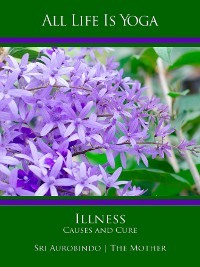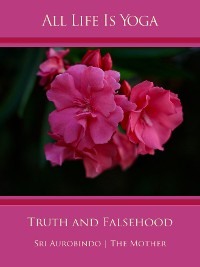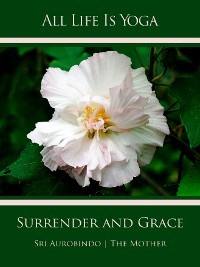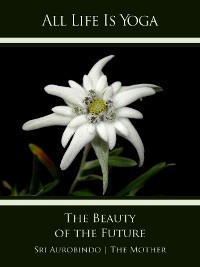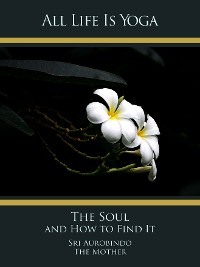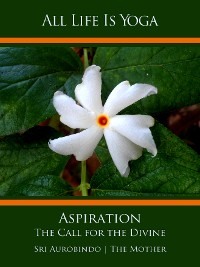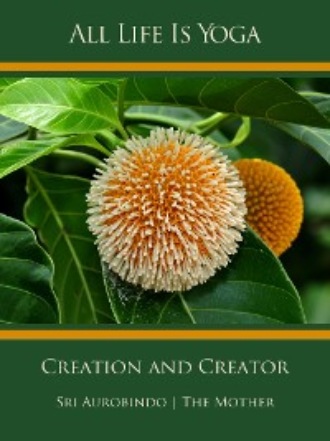
Полная версия
All Life Is Yoga: Creation and Creator

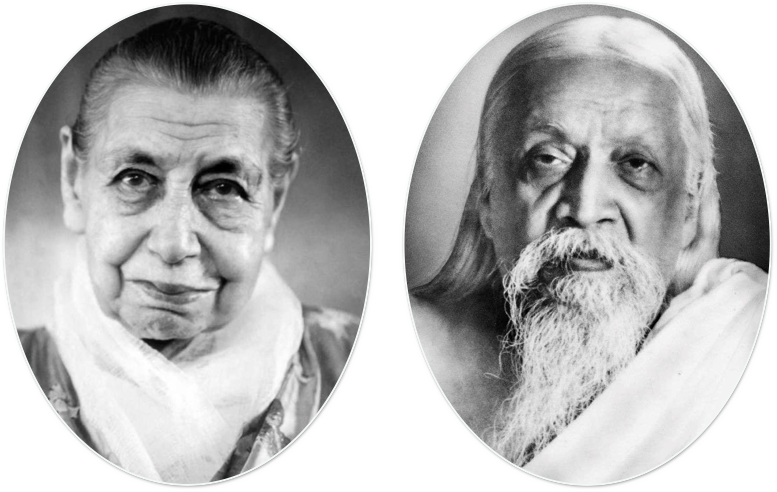
Omsriaurobindomira
All
Life
Is
Yoga
“All life is Yoga.” – Sri Aurobindo
Creation and Creator
Sri Aurobindo | The Mother

SRI AUROBINDO
DIGITAL EDITION

Copyright 2020
AURO MEDIA
Verlag und Fachbuchhandel
Wilfried Schuh
www.auro.media
www.savitri.center
www.sriaurobindo.center
eBook Design

SRI AUROBINDO DIGITAL EDITION
Germany, Berchtesgaden
ALL LIFE IS YOGA
Creation and Creator Selections from the Works of the Mother First edition 2020 ISBN 978-3-96387-063-7
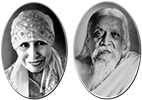
© Photos and selections of the works of Sri Aurobindo and the Mother:
Sri Aurobindo Ashram Trust
Puducherry, India

Flower on the cover:
Anthoeephalus cadamba. Golden yellow. Spiritual significance and explanation given by the Mother: Supramental sun We aspire that its rays may illumine and transform us.
Publisher’s Note
This is one in a series of some e-books created by SRI AUROBINDO DIGITAL EDITION and published by AURO MEDIA under the title All Life Is Yoga. Our effort is to bring together, from Sri Aurobindo and the Mother, simple passages with a practical orientation on specific subjects, so that everyone may feel free to choose a book according to his inner need. The topics cover the whole field of human activity, because true spirituality is not the rejection of life but the art of perfecting life.
While the passages from Sri Aurobindo are in the original English, most of the passages from the Mother (selections from her talks and writings) are translations from the original French. We must also bear in mind that the excerpts have been taken out of their original context and that a compilation, in its very nature, is likely to have a personal and subjective approach. A sincere attempt, however, has been made to be faithful to the vision of Sri Aurobindo and the Mother. These excerpts are by no means exhaustive.
Bringing out a compilation from the writings of Sri Aurobindo and the Mother, which have a profound depth and wideness unique, is a difficult task. The compiler’s subjective tilt and preferences generally result in highlighting some aspects of the issues concerned while the rest is by no means less significant. Also without contexts of the excerpts the passages reproduced may not fully convey the idea – or may be misunderstood or may reduce a comprehensive truth into what could appear like a fixed principle.
The reader may keep in mind this inherent limitation of compilations; compilations are however helpful in providing an introduction to the subject in a handy format. They also give the readers a direct and practical feel of some of the profound issues and sometimes a mantric appeal, musing on which can change one’s entire attitude to them.
The excerpts from the writings of Sri Aurobindo and the Mother carry titles and captions chosen by the editor, highlighting the theme of the excerpts and, whenever possible, borrowing a phrase from the text itself. The sources of the excerpts are given at the end of each issue.
We hope these compilations will inspire the readers to go to the complete works of Sri Aurobindo and the Mother and will help them to mould their lives and their environments towards an ever greater perfection.
“True spirituality is not to renounce life, but to make life perfect with a Divine Perfection.” – The Mother
* * *
ContentsTitle PageCopyrightPublisher’s NoteI. BRAHMAN: ONENESS OF GOD AND THE WORLDQuotation1. Brahman – The Unity2. Transitional Thought – The Many3. The Running of the Gods4. The Principle of Life5. Transitional Thought – The Waters6. The Vision of the BrahmanII. THE DIVINE AND THE UNIVERSEQuotation1. Understanding the Creation and the Creator2. A Story to Understand the How of Creation3. Descent of the Divine Love and an Uninterrupted Ascent4. How Were Gods and Goddesses Born?5. Divine Mother – The Creatrix6. The Creation Is Not an Illusion7. The Creation Is Not a Bad Joke8. The Creation Is Not a “Fall”9. The Why of Creation10. The Purpose of Creation11. The Intention of Nature12. The Goal13. Some Childish Notions14. The Idea of “God the Creator”15. The Seventh Creation16. The Creation of Equilibrium17. No Beginning, No End18. The Whither of Creation19. What is Being Done in the Eternity of Time20. Universe: The Manifestation of the Divine21. Who is He?22. If All is He, Why We Do Not Feel Him23. Creation and the Creator Are Not Separate24. The Cause and Remedy of All Deformations25. The Universe is Essentially Delight26. Is it the Best that Happens at Every Minute?27. Why a Progressive Universe28. Time and Space29. Consciousness: The Fundamental Thing in Existence30. Central Motive of Terrestrial Existence31. A Consciousness Simultaneously Individual and Total32. Unity in Diversity33. Beings on the Other Planets34. The Final Goal!APPENDIXReferencesGuideCoverTable of ContentsStart Reading

Sri Aurobindo
We are all gods and creators, because the energy of God is within us and all life is creation; not only the making of new forms is creation, but preservation is creation, destruction itself is creation. — Sri Aurobindo
* * *
Chapter 1
Brahman – The Unity
Isha Upanishad Verses 4-5
4. One unmoving that is swifter than Mind; That the Gods reach not, for It progresses ever in front. That, standing, passes beyond others as they run. In That the Master of Life establishes the Waters.
5. That moves and That moves not; That is far and the same is near; That is within all this and That also is outside all this.
* * *
The Lord and the world, even when they seem to be distinct, are not really different from each other; they are one Brahman.
*
“One Unmoving”
God is the one stable and eternal Reality. He is One because there is nothing else, since all existence and non-existence are He. He is stable or unmoving, because motion implies change in Space and change in Time, and He, being beyond Time and Space, is immutable. He possesses eternally in Himself all that is, has been or ever can be, and He therefore does not increase or diminish. He is beyond causality and relativity and therefore there is no change of relations in His being.
*
“Swifter than Mind”
The world is a cyclic movement (samsara) of the Divine Consciousness in Space and Time. Its law and, in a sense, its object is progression; it exists by movement and would be dissolved by cessation of movement. But the basis of this movement is not material; it is the energy of active consciousness which, by its motion and multiplication in different principles (different in appearance, the same in essence), creates oppositions of unity and multiplicity, divisions of Time and Space, relations and groupings of circumstance and Causality. All these things are real in consciousness, but only symbolic of the Being, somewhat as the imaginations of a creative Mind are true representations of itself, yet not quite real in comparison with itself, or real with a different kind of reality.
But mental consciousness is not the Power that creates the universe. That is something infinitely more puissant, swift and unfettered than the mind. It is the pure omnipotent self-awareness of the Absolute unbound by any law of the relativity. The laws of the relativity, upheld by the gods, are Its temporary creations. Their apparent eternity is only the duration, immeasurable to us, of the world which they govern. They are laws regularising motion and change, not laws binding the Lord of the movement. The gods, therefore, are described as continually running in their course. But the Lord is free and unaffected by His own movement.
*
“That Moves, that Moves Not”
The motion of the world works under the government of a perpetual stability. Change represents the constant shifting of apparent relations in an eternal Immutability.
It is these truths that are expressed in the formulae of the one Unmoving that is swifter than Mind, That which moves and moves not, the one Stable which outstrips in the speed of its effective consciousness the others who run.
* * *
Chapter 2
Transitional Thought – The Many1
If the One is pre-eminently real, “the others”, the Many are not unreal. The world is not a figment of the Mind.
Unity is the eternal truth of things, diversity a play of the unity. The sense of unity has therefore been termed Knowledge, Vidya, the sense of diversity Ignorance, Avidya. But diversity is not false except when it is divorced from the sense of its true and eternal unity.
Brahman is one, not numerically, but in essence. Numerical oneness would either exclude multiplicity or would be a pluralistic and divisible oneness with the Many as its parts. That is not the unity of Brahman, which can neither be diminished nor increased, nor divided.
The Many in the universe are sometimes called parts of the universal Brahman as the waves are parts of the sea. But, in truth, these waves are each of them that sea, their diversities being those of frontal or superficial appearances caused by the sea’s motion. As each object in the universe is really the whole universe in a different frontal appearance, so each individual soul is all Brahman regarding Itself and world from a centre of cosmic consciousness.
For That is identical, not single. It is identical always and everywhere in Time and Space, as well as identical beyond Time and Space. Numerical oneness and multiplicity are equally valid terms of its essential unity.
These two terms, as we see them, are like all others, representations in Chit, in the free and all-creative self-awareness of the Absolute regarding itself variously, infinitely, innumerably and formulating what it regards. Chit is a power not only of knowledge, but of expressive will, not only of receptive vision, but of formative representation; the two are indeed one power. For Chit is an action of Being, not of the Void. What it sees, that becomes. It sees itself beyond Space and Time; that becomes in the conditions of Space and Time.
Creation is not a making of something out of nothing or of one thing out of another, but a self-projection of Brahman into the conditions of Space and Time. Creation is not a making, but a becoming in terms and forms of conscious existence.
In the becoming each individual is Brahman variously represented and entering into various relations with Itself in the play of the divine consciousness; in being, each individual is all Brahman.
Brahman as the Absolute or the Universal has the power of standing back from Itself in the relativity. It conceives, by a subordinate movement of consciousness, the individual as other than the universal, the relative as different from the Absolute. Without this separative movement, the individual would always tend to lose itself in the universal, the relative to disappear into the Absolute. Thus, It supports a corresponding reaction in the individual who regards himself as “other” than the transcendent and universal Brahman and “other” than the rest of the Many. He puts identity behind him and enforces the play of Being in the separative Ego.
The individual may regard himself as eternally different from the One, or as eternally one with It, yet different, or he may go back entirely in his consciousness to the pure Identity.2 But he can never regard himself as independent of some kind of Unity, for such a view would correspond to no conceivable truth in the universe or beyond it.
These three attitudes correspond to three truths of the Brahman which are simultaneously valid and none of them entirely true without the others as its complements. Their coexistence, difficult of conception to the logical intellect, can be experienced by identity in consciousness with Brahman.
Even in asserting Oneness, we must remember that Brahman is beyond our mental distinctions and is a fact not of Thought that discriminates, but of Being which is absolute, infinite and escapes discrimination. Our consciousness is representative and symbolic; it cannot conceive the thing-in-itself, the Absolute, except by negation, in a sort of void, by emptying it of all that it seems in the universe to contain. But the Absolute is not a void or negation. It is all that is here in Time and beyond Time.
Even oneness is a representation and exists in relation to multiplicity. Vidya and Avidya are equally eternal powers of the supreme Chit. Neither Vidya nor Avidya by itself is the absolute knowledge.
Still, of all relations oneness is the secret base, not multiplicity. Oneness constitutes and upholds the multiplicity, multiplicity does not constitute and uphold the oneness.
Therefore we have to conceive of oneness as our self and the essential nature of Being, multiplicity as a representation of Self and a becoming. We have to conceive of the Brahman as One Self of all and then return upon the Many as becomings of the One Being (bhutani ... atman). But both the Self and the becomings are Brahman; we cannot regard the one as Brahman and the others as unreal and not Brahman. Both are real, the one with a constituent and comprehensive, the others with a derivative or dependent reality.
* * *
1 The series of ideas under this heading seem to me to be the indispensable metaphysical basis of the Upanishad. The Isha Upanishad does not teach a pure and exclusive Monism; it declares the One without denying the Many and its method is to see the One in the Many. It asserts the simultaneous validity of Vidya and Avidya and upholds as the object of action and knowledge an immortality consistent with Life and Birth in this world. It regards every object as itself the universe and every soul as itself the divine Purusha. The ensemble of these ideas is consistent only with a synthetic or comprehensive as opposed to an illusionist or exclusive Monism.
2 The positions, in inverse order, of the three principal philosophical schools of Vedanta, Monism, Qualified Monism and Dualism.
Chapter 3
The Running of the Gods
Brahman representing Itself in the universe as the Stable, by Its immutable existence (Sat), is Purusha, God, Spirit; representing Itself as the Motional, by Its power of active Consciousness (Chit), is Nature, Force or World-Principle (Prakriti, Shakti, Maya).1 The play of these two principles is the Life of the universe.
The Gods are Brahman representing Itself in cosmic Personalities expressive of the one Godhead who, in their impersonal action, appear as the various play of the principles of Nature.
The “others” are sarvani bhutani of a later verse, all becomings, Brahman representing itself in the separative consciousness of the Many.
Everything in the universe, even the Gods, seems to itself to be moving in the general movement towards a goal outside itself or other than its immediate idea of itself. Brahman is the goal; for it is both the beginning and the end, the cause and the result of all movement.
But the idea of a final goal in the movement of Nature itself is illusory. For Brahman is Absolute and Infinite. The Gods, labouring to reach him, find, at every goal that they realise, Brahman still moving forward in front to a farther realisation. Nothing in the appearances of the universe can be entirely That to the relative consciousness; all is only a symbolic representation of the Unknowable.
All things are already realised in Brahman. The running of the Others in the course of Nature is only a working out (Prakriti), by Causality, in Time and Space, of something that Brahman already possesses.
Even in Its universal being Brahman exceeds the Movement. Exceeding Time, It contains in Itself past, present and future simultaneously and has not to run to the end of conceivable Time. Exceeding Space, It contains all formations in Itself coincidently and has not to run to the end of conceivable Space. Exceeding Causality, It contains freely in Itself all eventualities as well as all potentialities without being bound by the apparent chain of causality by which they are linked in the universe. Everything is already realised by It as the Lord before it can be accomplished by the separated Personalities in the movement.
* * *
1 Prakriti, executive Nature as opposed to Purusha, which is the Soul governing, taking cognizance of and enjoying the works of Prakriti. Shakti, the self-existent, self-cognitive, self-effective Power of the Lord (Ishwara, Deva or Purusha), which expresses itself in the workings of Prakriti. Maya, signifying originally in the Veda comprehensive and creative knowledge, Wisdom that is from of old; afterwards taken in its second and derivative sense, cunning, magic, Illusion. In this second significance it can really be appropriate only to the workings of the lower Nature, apara prakrti, which has put behind it the Divine Wisdom and is absorbed in the experiences of the separative Ego. It is in the more ancient sense that the word Maya is used in the Upanishads, where, indeed, it occurs but rarely.
Chapter 4
The Principle of Life
Matarishwan and the Waters
What then is Its intention in the movement?
The movement is a rhythm, a harmony which That, as the Universal Life, works out by figures of Itself in the terms of conscious Being. It is a formula symbolically expressive of the Unknowable, – so arranged that every level of consciousness really represents something beyond itself, depth of depth, continent of continent. It is a play1 of the divine Consciousness existing for its own satisfaction and adding nothing to That, which is already complete. It is a fact of conscious being, justified by its own existence, with no purpose ulterior to itself. The idea of purpose, of a goal is born of the progressive self-unfolding by the world of its own true nature to the individual Souls inhabiting its forms; for the Being is gradually self-revealed within its own becomings, real Unity emerges out of the Multiplicity and changes entirely the values of the latter to our consciousness.
This self-unfolding is governed by conditions determined by the complexity of consciousness in its cosmic action.
For consciousness is not simple or homogeneous, it is septuple. That is to say, it constitutes itself into seven forms or grades of conscious activity descending from pure Being to physical being. Their interplay creates the worlds, determines all activities, constitutes all becomings.
Brahman is always the continent of this play or this working. Brahman self-extended in Space and Time is the universe.
In this extension Brahman represents Itself as formative Nature, the universal Mother of things, who appears to us, first, as Matter, called Prithivi, the Earth-Principle.
Brahman in Matter or physical being represents Itself as the universal Life-Power, Matarishwan, which moves there as a dynamic energy, Prana, and presides effectively over all arrangement and formation.
Universal Life establishes, involved in Matter, the septuple consciousness; and the action of Prana, the dynamic energy, on the Matrix of things evolves out of it its different forms and serves as a basis for all their evolutions.
* * *
1 This is the Vaishnava image of the Lila applied usually to the play of the Personal Deity in the world, but equally applicable to the active impersonal Brahman.
Chapter 5
Transitional Thought – The Waters
There are, then, seven constituents of Chit active in the universe.
We are habitually aware of three elements in our being, Mind, Life and Body. These constitute for us a divided and mutable existence which is in a condition of unstable harmony and works by a strife of positive and negative forces between the two poles of Birth and Death. For all life is a constant birth or becoming. All birth entails a constant death or dissolution of that which becomes, in order that it may change into a new becoming. Therefore this state of existence is called Mrityu, Death, and described as a stage which has to be passed through and transcended.
For this is not the whole of our being and, therefore, not our pure being. We have, behind, a superconscious existence which has also three constituents, Sat, Chit-Tapas and Ananda.
Sat is essence of our being, pure, infinite and undivided, as opposed to this divisible being which founds itself on the constant changeableness of physical substance. Sat is the divine counterpart of physical substance.
Chit-Tapas is pure energy of Consciousness, free in its rest or its action, sovereign in its will, as opposed to the hampered dynamic energies of Prana which, feeding upon physical substances, are dependent on and limited by their sustenance.1 Tapas is the divine counterpart of this lower nervous or vital energy.
Ananda is Beatitude, the bliss of pure conscious existence and energy, as opposed to the life of the sensations and emotions which are at the mercy of the outward touches of Life and Matter and their positive and negative reactions, joy and grief, pleasure and pain. Ananda is the divine counterpart of the lower emotional and sensational being.
This higher existence, proper to the divine Sachchidananda, is unified, self-existent, not confused by the figures of Birth and Death. It is called, therefore, Amritam, Immortality, and offered to us as the goal to be aimed at and the felicity to be enjoyed when we have transcended the state of death.
The higher divine is linked to the lower mortal existence by the causal Idea2 or supramental Knowledge-Will, Vijnana. It is the causal Idea which, by supporting and secretly guiding the confused activities of the Mind, Life and Body, ensures and compels the right arrangement of the universe. It is called in the Veda the Truth because it represents by direct vision the truth of things both inclusive and independent of their appearances; the Right or Law, because, containing in itself the effective power of Chit, it works out all things according to their nature with a perfect knowledge and prevision; the Vast, because it is of the nature of an infinite cosmic Intelligence comprehensive of all particular activities.
Vijnana, as the Truth, leads the divided consciousness back to the One. It also sees the truth of things in the multiplicity. Vijnana is the divine counterpart of the lower divided intelligence.


